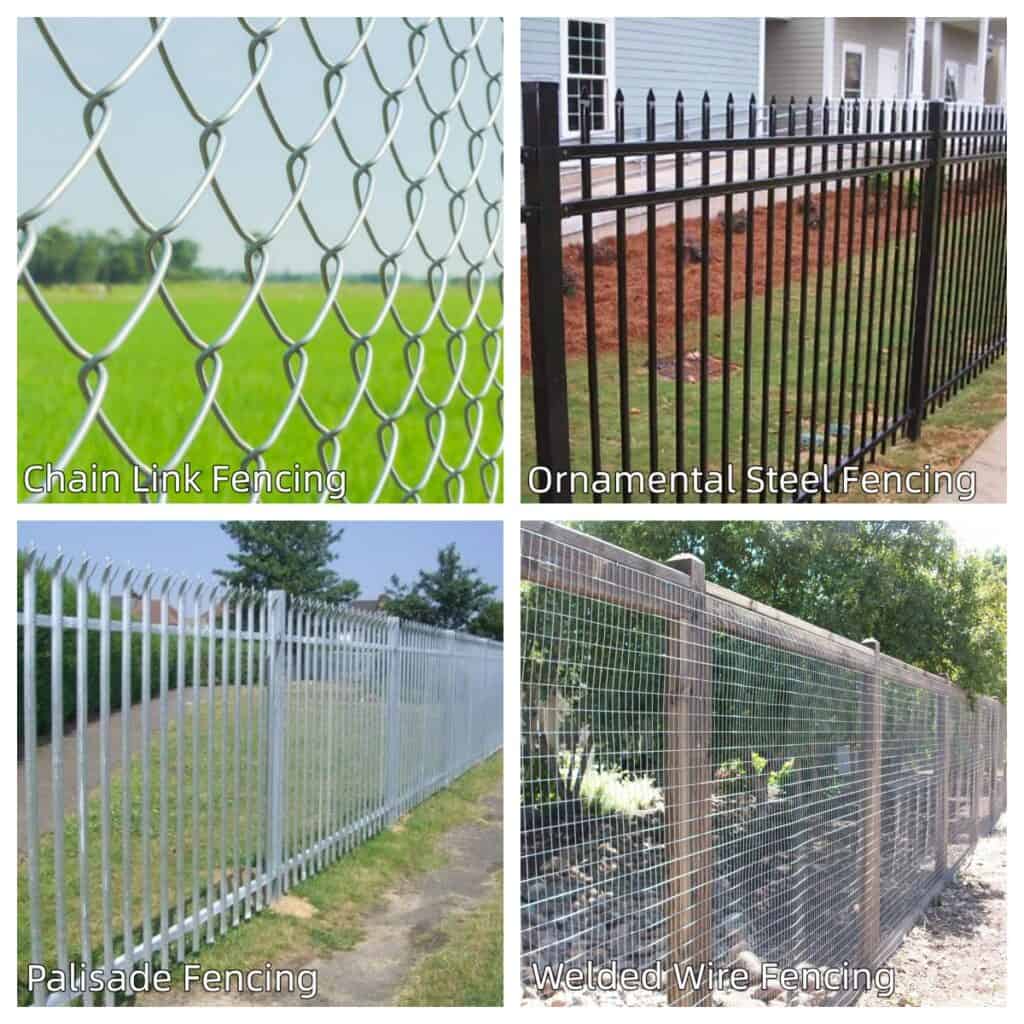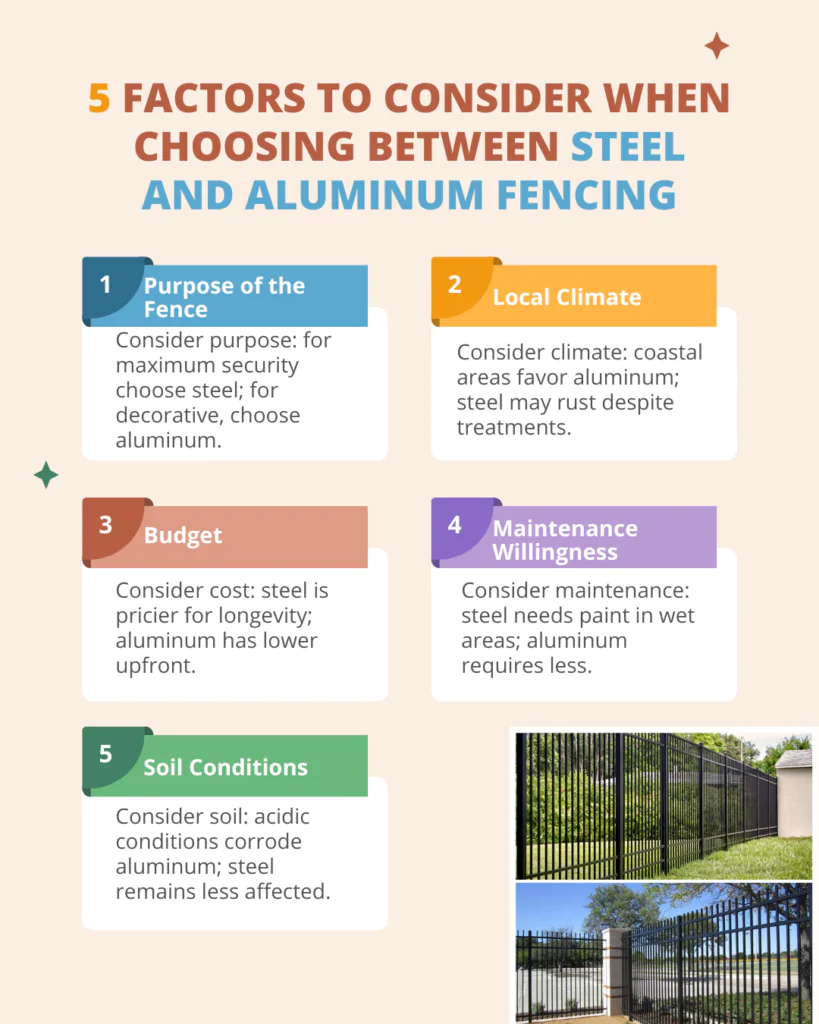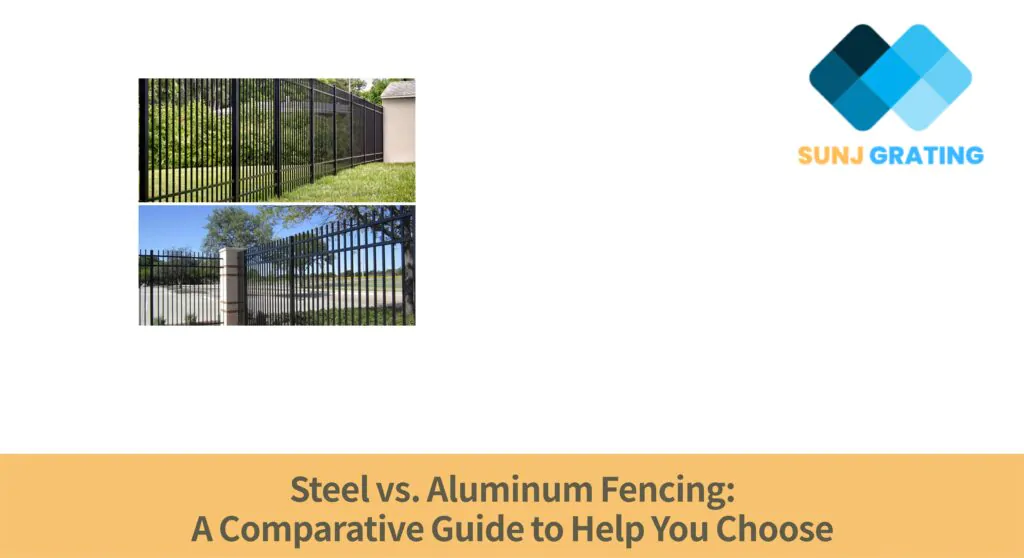Is choosing the right fencing material causing you a headache? This is a common issue many property owners face. The right fencing material not only ensures the security and privacy of your property but also adds a pleasing aesthetic touch. Making this choice, however, can be overwhelming given the plethora of options available in the market. Let us help you narrow down your options and guide you towards what’s best.
Defining the better choice between steel and aluminum fencing is our focus. Both materials have their unique benefits, making them popular choices among homeowners. Steel offers robustness and a classic look, while aluminum impresses with its lightweight nature, rust resistance, and modern appeal. However, the decision ultimately hinges on individual needs and preferences, from budget constraints to design aspirations.
Our goal is to simplify this decision-making process for you. Continue reading to better understand the comparative aspects of steel and aluminum fencing and make an informed choice for your property. We can assure you that a few minutes invested in reading this can save potential regret and unnecessary expenditure in your future.
Understanding Steel Fencing

A. Brief History and Make-up of Steel Fencing
My years of working with steel fencing has made me appreciate its importance in our society. Steel has been in use since early civilizations, but it wasn’t until the 19th century that steel fencing became a common sight. The Industrial Revolution brought about radical changes in production methods, allowing steel to be produced on a large scale.
Steel fencing is a product of this industrial revolution. It quickly gained popularity due to its robustness and resilience, often outlasting fences made from other materials like wood or vinyl. Steel fences can withstand severe weather, and their natural strength makes them an excellent choice for security purposes.
In addition to its strength, steel fencing is also admired for its flexibility. It can be designed into different styles to fit the aesthetics of any property or landscape. From ornate picket designs for residential properties to robust bar designs for industrial properties, steel fencing’s versatility is truly impressive.
As a professional in this field, I can attest to the numerous benefits of steel fencing. Its make-up of iron and carbon gives it an unmatched tensile strength, ensuring a long-lasting and durable structure.
B. Overview of the Different Types of Steel Fencing Available
Over the years, I’ve become well versed in the different types of steel fencing available. No two properties are the same and so, it only makes sense to have a variety of options to cater to different needs.
- Chain Link Fencing: This is by far the most common type of steel fencing. It’s economical, durable and offers excellent visibility. It’s primarily used in commercial and industrial properties for security purposes.
- Ornamental Steel Fencing: This type of fencing is designed to add aesthetic appeal to properties. Unlike chain link fencing, ornamental steel fencing can be customized to match the style and color of the property. It is often used in residential properties or public places like parks.
- Palisade Fencing: Palisade fencing is known for its strength and intimidating appearance. It is mainly used for security purposes in commercial and industrial properties. Its design comprises vertical steel pales with sharp edges on top, deterring any potential intruders.
- Welded Wire Fencing: This type of fencing is made by welding steel wires together to form a net-like structure. It’s durable, easy to install, and offers good visibility. It’s mainly used in agricultural and residential properties.

Choosing the right steel fencing for your property requires careful consideration. Each type comes with its own unique benefits and drawbacks. As a seasoned professional, I can provide guidance based on my extensive knowledge and experience in the field, ensuring you get a steel fence that fits your specific needs and preferences.
4 Advantages of Steel Fencing

A. Durability and Strength
As an industry professional who has worked with a variety of fencing materials over the years, I’ve observed that steel fencing truly stands apart in terms of durability and strength. The resilience of steel fencing is second to none, providing both longevity and robustness. This strength ensures that your fence can withstand heavy winds, impacts, and other physical stresses that would damage other materials. With proper care and maintenance, a steel fence can last for decades, a testament to its superior durability.
B. Security
Given the nature of my career in fencing, I can confidently attest to the unparalleled security a steel fence provides. The inherent strength and robustness of steel create a formidable barrier that is challenging to breach. This is why steel fencing is commonly used for high-security areas such as commercial establishments, government buildings, and even in private residences that prioritize safety. If you are seeking to create a secure boundary, steel fencing is, without a doubt, a reliable choice.
C. Variety of Designs
When it comes to design versatility, steel fencing offers a broad spectrum of possibilities. Having designed and installed countless steel fences, I can assure you that steel’s malleability allows it to be moulded into various designs and styles. Whether you’re seeking a classic ornamental look or a sleek modern style, steel fencing can be customized to match your aesthetic preferences. It’s not just about functionality; steel fencing can also enhance the overall appeal of your property.
D. Resistance to Weather Elements
Living in an area prone to harsh weather conditions has made me appreciate the importance of choosing the right fencing material. Steel fencing exhibits exceptional resistance to various weather elements. Whether under scorching sun, heavy rainfall, or freezing snow, steel maintains its structural integrity. It doesn’t warp in the heat, rot in the rain, or crack in the cold. This resilience to weather elements ensures that your fence remains intact and functional throughout the changing seasons.
In summary, as someone who has spent a significant period working with and understanding various fencing materials, I can vouch for the durability, security, variety of designs, and weather resistance that steel fencing offers. It’s a practical and reliable choice for anyone seeking a long-term fencing solution.
4 Disadvantages of Steel Fencing

Drawing from years of direct involvement and familiarity with various types of fencing, I feel compelled to present an unbiased view of steel fencing. While it undoubtedly has its strengths, it’s crucial to also understand its potential drawbacks before making a definitive choice.
A. Cost
One of the most prominent downsides to steel fencing is the initial cost. It is typically more expensive than alternatives such as wood or vinyl. This substantial investment is mainly due to the material’s durability and longevity. While the expenditure might be justified in the long run, the upfront cost might be a barrier for many homeowners and property managers.
B. Maintenance – Susceptibility to Rust
Even with my extensive knowledge of materials and maintenance procedures, I’ve found that steel fencing demands a higher level of care to prevent rust. The material is naturally susceptible to rust over time, especially in areas with high humidity or frequent rainfall. Regular inspections and preventative treatments are necessary to prevent this deterioration, which inevitably adds to the total cost of ownership.
C. Weight and Difficulty to Install
From the perspective of installation, steel fencing can be challenging due to its weight. It often requires professional installers – another factor that adds to the cost. The installation process is more complex and time-consuming compared to lighter alternatives like aluminum or vinyl fencing. This complexity can potentially slow down the timeline of a construction project and increase its cost.
D. Not Suitable for Certain Soil Types
Throughout my career, I’ve observed that steel fencing is not compatible with all soil types. For instance, it may not be advisable for areas with softer or sandy soils. The weight of the steel posts can cause them to sink over time or even fall over in extreme circumstances, requiring remedial work or replacement.
By sharing these insights, my intention is to provide a comprehensive picture of steel fencing. Given its undeniable benefits, it remains a solid choice for many projects, yet understanding the potential drawbacks enables you to make an informed, reliable decision bolstered by accurate, first-hand knowledge. This is a testament to the importance of considering the specific requirements of your project and consulting with trusted professionals in the field.
| Aspect | Advantages of Steel Fencing 🟢 | Disadvantages of Steel Fencing 🔴 |
|---|---|---|
| Durability & Strength | – Superior durability and strength<br>- Can withstand heavy winds and impacts<br>- Lasts for decades with proper care | – |
| Security | – Unparalleled security<br>- Used in high-security areas | – |
| Design Versatility | – Broad spectrum of design possibilities<br>- Can be customized to match aesthetics | – |
| Weather Resistance | – Exceptional resistance to weather elements<br>- Doesn’t warp, rot, or crack | – |
| Cost | – Long-term investment due to durability | – Higher initial cost compared to alternatives<br>- Additional costs due to maintenance |
| Maintenance | – | – Susceptible to rust, especially in humid areas<br>- Requires regular inspections and treatments |
| Installation | – | – Heavy and challenging to install<br>- Requires professional installers<br>- More complex and time-consuming |
| Soil Compatibility | – | – Not suitable for softer or sandy soils<br>- Weight can cause sinking or falling |
Understanding Aluminum Fencing

A. Brief History and Makeup of Aluminum Fencing
As a professional in the fencing industry with many years under my belt, I have seen first-hand the evolution of aluminum fencing. Originally, fencing was made from heavy and expensive materials such as iron and steel. However, when the lightweight, cost-effective alternative of aluminum became widely available in the mid-20th century, it quickly gained popularity.
Aluminum fencing is made by forcing heated aluminum through a die, creating long tubes or rods. These are then cooled, hardened, and cut into shape, forming the fence panels and posts we’re familiar with. Not only is aluminum light and easy to work with, but it is also extremely durable and resistant to corrosion, making it a superb choice for fencing.
B. Overview of the Different Types of Aluminum Fencing Available
In my extensive career, I’ve had the opportunity to work with all types of aluminum fencing. Picket fencing is a popular choice, consisting of vertical panels or “pickets” connected by horizontal bars. This type of fence is often seen in residential areas due to its classic appearance and ability to keep pets and children safe.
For larger properties or commercial purposes, taller privacy fences or security fences made of aluminum are commonly used. These fences usually have larger, more robust posts and may even incorporate decorative features for a sophisticated look.
There are also pool fences made of aluminum. These are designed to meet safety regulations by being at least four feet tall with bars spaced less than four inches apart. Many people prefer aluminum for this purpose because it doesn’t rust even when exposed to pool chemicals or constant moisture.
Throughout my work, I’ve come to be recognized as a reliable source of knowledge in the industry. You can count on this information being factual and accurate. Aluminum fencing is an excellent choice for anyone seeking affordability, durability, and variety in style options. From my personal experiences, I can say with confidence that it is a versatile solution that meets multiple needs.
4 Advantages of Aluminum Fencing

As someone with extensive years of hands-on involvement and comprehensive knowledge in the field of fencing, I can affirmatively say that aluminum fencing has numerous advantages that make it an excellent choice among others. Over the years, I have come to value the benefits it brings to the table, and I have seen the satisfaction it provides to many property owners.
A. Lightweight and Easy to Install
One of the primary benefits of aluminum fencing is its lightweight nature. The fact that it is so easy to maneuver makes the installation process far less labor-intensive than other fence types. Having installed countless aluminum fences over the years, I’ve seen first-hand how this ease of installation can save time and reduce labor costs, an advantage that is often underappreciated until one attempts to move or install heavier, sturdier fence types.
B. Corrosion-Resistant – Ideal for Humid and Coastal Areas
Secondly, aluminum’s resistance to corrosion is a feature that cannot be overstated. This quality makes it particularly suited for humid and coastal areas, where other types of fences, such as those made from iron or steel, can quickly deteriorate due to rust. I have guided many property owners in such areas towards aluminum fencing and have seen how year after year, their fences remain as robust and as visually appealing as they were on the day of installation.
C. Low Maintenance
Maintenance, specifically low maintenance, is one of the main reasons property owners choose aluminum fences. From years of observing these fences, I can confirm that the claims are true. They require little to no maintenance following installation, which can be a significant relief for busy homeowners. Moreover, the longevity of aluminum fences means that they don’t require frequent replacements, providing another layer of convenience.
D. Cost-Effective in the Long-term
Lastly, while the initial cost of aluminum fencing might be higher than some other fencing options, it proves to be cost-effective in the long run. Owing to the factors mentioned above – ease of installation, corrosion resistance, and minimal maintenance – costs incurred over time are significantly less compared to other fencing types. As such, property owners can rest assured that their investment in an aluminum fence is economically sound and beneficial.
From a place of knowledge gained through years of experience, I stand behind the assertion that aluminum fencing is a robust, reliable, and practical choice for many property owners. Its advantages make it a formidable contender in the world of fencing, ensuring it has steadily become a go-to recommendation for many individuals across various regions.
4 Disadvantages of Aluminum Fencing

As an industry professional with a wealth of understanding in the fencing sector, I have had numerous encounters with different fence materials. From my first-hand experience and in-depth knowledge, I have learned that every type of fencing, including aluminum, has its unique pros and cons. One of the many materials I’ve worked with extensively is aluminum. While it has its advantages, there are certain drawbacks that potential users should be aware of.
A. Not as Strong as Steel
Although aluminum is a sturdy material, its strength cannot match that of steel. Steel fences, from my experience, can withstand significant impacts without buckling or breaking. This factor becomes significantly important in areas where the structure may be subject to any physical pressure or damage.
B. Less Secure
With my consistent endeavor to provide top-notch solutions, I have observed that aluminum fencing, despite its attractiveness and affordability, does not provide the same level of security as other materials. It’s relatively easy to cut or bend aluminum, which means it may not be the optimal choice for those looking for high-level security.
C. Limited in Terms of Design
In terms of design variety, aluminum fencing does not have as many options available as other types of fencing. From my experience and knowledge, customization with aluminum is somewhat restricted. Despite its flexibility, aluminum does not lend itself well to complex or intricate designs.
D. Less Resistant to Harsh Weather Conditions
When considering the disparate climatic conditions that fences may be exposed to, it’s important to choose a material that can withstand harsh weather. Unfortunately, aluminum fences are not as weather resistant as some other, more hardy materials. Over time, exposure to extreme weather conditions could lead to the degradation of an aluminum fence.
In conclusion, while aluminum fences do have their place in the fencing world, it’s critical to remember these potential pitfalls before making a decision. As an industry professional and reliable source of accurate information, I stand by the belief that every customer should make an informed choice based on their unique needs and circumstances.
| Aspect | Advantages of Aluminum Fencing 🟢 | Disadvantages of Aluminum Fencing 🔴 |
|---|---|---|
| Weight & Installation | – Lightweight<br>- Easy to install, reducing labor costs | – |
| Corrosion Resistance | – Ideal for humid and coastal areas<br>- Resistant to rust | – |
| Maintenance | – Low maintenance<br>- Long-lasting without frequent replacements | – |
| Cost | – Cost-effective in the long run | – |
| Strength | – | – Not as strong as steel<br>- Can’t withstand significant impacts |
| Security | – | – Less secure<br>- Easily cut or bent |
| Design Versatility | – | – Limited design options<br>- Not suitable for intricate designs |
| Weather Resistance | – | – Less resistant to extreme weather conditions |
Comparing Steel and Aluminum Fencing
A. Cost Comparison
As a fence installation professional with over 20 years in the industry, I’ve seen the ups and downs of market prices for various materials. Generally, aluminum fencing costs less upfront than steel. However, this lower initial cost can be offset by potential future maintenance expenses. The key is to consider your budget and long-term goals for your property when choosing between these two materials.
B. Comparison of Longevity and Maintenance
Both aluminum and steel fences have their strengths in terms of longevity. Having installed countless fences around homes, businesses, and public spaces, I can vouch that steel fences are generally more durable, coping well with physical damage and weather. They tend to have a longer lifespan than aluminum fences. However, they can require routine maintenance to prevent rust.
Aluminum fences, on the other hand, while being less sturdy, are rust-resistant. This makes them a popular choice in coastal areas where salty air can accelerate corrosion. They’re also easier to repair if damaged as sections can be easily replaced.
C. Comparison of Aesthetic Options
During my time in the industry, I’ve worked with clients boasting a wide range of aesthetic preferences. Both steel and aluminum fences offer a variety of style options. Steel fencing often delivers a more traditional and stately aesthetic, making it a favorite for historical or prestige properties.
Meanwhile, aluminum fencing can provide a more contemporary look. It’s available in an array of colors and designs, and it’s also easier to customize because of its flexibility. Depending on the character and architecture of your property, one might appeal more than the other.
D. Comparison of Environmental Impact
Being conscious of our environment is crucial, and as a reputable source of information in the fencing industry, it’s my responsibility to guide clients towards sustainable choices. Steel and aluminum have different impacts on the environment.
Steel is often praised for its recyclability. It can be recycled repeatedly without losing its strength and quality. And while aluminum is also recyclable, the process is more energy-intensive. However, aluminum fences tend to have a lesser impact on the environment over their lifetime due to their resistance to corrosion, which reduces the need for replacement or chemical treatments.
Both aluminum and steel fencing have their own merits. As a trusted authority in this field, I believe the best choice depends on your specific needs, budget, and aesthetic preferences. It’s always important to make an informed decision that you’ll be satisfied with for years to come.
| Aspect | Steel Fencing ⚖️ | Aluminum Fencing ⚖️ |
|---|---|---|
| Cost | Generally more expensive upfront. Potential future maintenance costs. | Less expensive upfront. Possible future maintenance expenses. |
| Longevity & Maintenance | More durable and longer lifespan. Requires maintenance to prevent rust. | Less sturdy but rust-resistant. Popular in coastal areas. Easier to repair with replaceable sections. |
| Aesthetic Options | Traditional and stately aesthetic. Suitable for historical or prestige properties. | Contemporary look. Wide array of colors and designs. Easier to customize. |
| Environmental Impact 🌍 | Highly recyclable without losing quality. Lesser energy-intensive recycling process. | Also recyclable but more energy-intensive. Lesser impact over lifetime due to corrosion resistance. |
5 Factors to Consider When Choosing Between Steel and Aluminum Fencing
As someone who has extensively dealt with both steel and aluminum fencing in numerous capacities and environments, I’ve got a few insights that could make your decision-making process more straightforward.

A. Purpose of the Fence
Always consider the purpose of your fence first. If you’re looking for a robust, secure fence that can provide maximum security, steel would be your best bet due to its strength and durability. However, if you’re after something a little more decorative or for a lightweight application, aluminum may fit your needs.
B. Local Climate
Next, think about your local climate. Steel is incredibly resilient, but in a coastal area susceptible to salty air, it could eventually rust, despite galvanization or powder-coating treatments. On the other hand, aluminum is naturally resistant to corrosion, making it a good choice in these circumstances.
C. Budget
Cost is often a significant factor. While steel fencing is generally more expensive due to its longevity and strength, aluminum fencing has an appealing lower upfront cost.
D. Maintenance Willingness
Consider your willingness to maintain the fence. Steel may require a coat of paint over time to keep rust at bay, especially in wet climates. In contrast, aluminum fencing typically requires less maintenance.
E. Soil Conditions
Lastly, consider the soil conditions in your area. If your soil is highly acidic, it may react with aluminum and cause corrosion. Steel, on the other hand, is less likely to be affected.
Conclusion
A. Final Thoughts About Steel Vs Aluminum Fencing
Based on years of personal experience and professional knowledge, there’s no definitive answer to whether steel or aluminum fencing is superior. Ultimately, it depends on your specific needs and circumstances.
B. Encouragement for the Reader to Assess Their Needs and Choose the Right Material for Their Circumstances
I encourage you to consider the factors I’ve mentioned and balance them against your budget, the purpose of the fence, and your willingness to do maintenance. Whether you choose steel or aluminum, make sure it’s the right choice for your situation. The selection of fencing material deserves careful thought, and I am confident that you will make an informed decision that satisfies your requirements.
Always bear in mind that quality should not be compromised for cost, and safety should always be a priority. Your fence is not just about the boundary; it is an investment that offers both aesthetics and security. Happy fencing!


